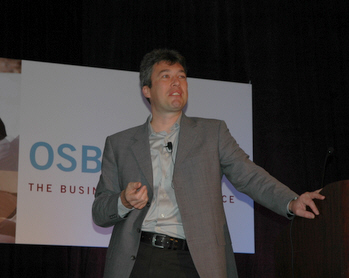SAP: Less mature open source won't survive enterprise consolidation

Peter Graf, SAP executive vice president of solution marketing, gave his company’s point of view on open source this morning at the Open Source Business Conference. He started out with a list of open source products that SAP uses, like every other enterprise software company, and how the total price-to-performance ratio of SAP on Linux was 50 times better on Linux than on Unix.
But his core message was that the vast majority of open source software is too immature and won’t have a chance to prove itself, meaning it won’t be a good, strategic choice for enterprises. “The key question for open source is which open source technologies are mature enough to survive the coming consolidation wave,” Graf said. “Linux and Eclipse are mature enough and most likely Mozilla, but others won’t have time to prove themselves to market before the wave hits. I see a lot of industry consolidation coming, which forces customers to consolidate…and they can’t afford to bet on smaller companies that may not be stable enough.”

The consolidation wave is both on the vendor side, such as Oracle soaking up proprietary and open source applications and tools, and among customers, who need to lower their cost and complexity.
Graf used the OSBC forum to invite the open source community assembled at the event--mostly the small open source startups that he said won’t have enough runway to prove themselves--to join SAP's community, which is embodied in SAP’s proprietary NetWeaver and Enterprise Service Repository. He touted the SAP developer community, which he said attracted 500,000 users per month.
After his keynote I asked Graf if he was really saying that most open source software--outside of LAMP and a few others--is doomed in enterprises. Clearly, the big companies like SAP, Oracle, IBM, Microsoft and others want to stay on top, and can be dismissive of open source projects that could be disruptive to their business models.
Graf responded, “We take an opportunistic view in terms of what are the open source solutions that customers are deploying. We are both a consumer and contributor to open source. We contribute to Linux and MySQL [SAP is an investor in MySQL]. We take a customer perspective and aren’t religious about open source. The industry is moving toward consolidation of vendors and the not so quickly growing IT budgets is driving enterprises to consolidate. The quesiton is , am I deploying open source tactically or strategically. There are technologies that are mature enough, but some are very early in hype cycle. There isn’t enough time even it they succeed in building an application and won’t have time to prove before consolidation really hit.”
The customer makes the decision whether open source product is immature, he concluded. As a vendor, Graf has made his sober decision about the growing wave of open source applications and tools.
Graf's keynote was followed by Kim Polese's talk on free markets and software. The CEO of SpikeSource, which packages up, tests and maintains open source software stacks, said that the software model of the future was working together. For example SpikeSource just announced that it would create a distribution that includes SugarCRM and the LAMP stack that enterprises can just plug into their enterprise and keep it current will all the patches and updates as part its support service. It's not hard to image that intermediaries with plug and play packaging and certification approaches like SpikeSource could take some of the uncertainty and immaturity out of the growing number of open source projects that could provide a viable alternative to the incumbents, and at less cost. John Roberts, CEO of SugarCRM, noted that his less than two-year-old startup CRM open source company (funded with $26 million, so not exactly immature from that viewpoint) has penetrated SAP accounts, such as Avid. I don't expect to see a lot of open source developers flocking to SAP's platform anytime soon, other than to plug their open source projects into SAP's application framework.